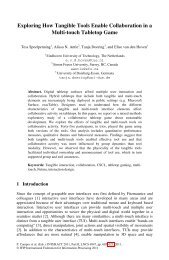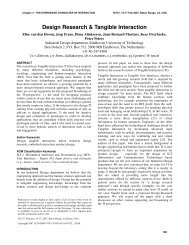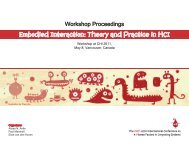Sissy - Elise van den Hoven
Sissy - Elise van den Hoven
Sissy - Elise van den Hoven
You also want an ePaper? Increase the reach of your titles
YUMPU automatically turns print PDFs into web optimized ePapers that Google loves.
his instruments and where he pointed to the x-ray. The<br />
shapes of the <strong>den</strong>tist and assistant also overlap in several<br />
places. One is in the centre of the drawing, which is the<br />
area of the patient’s mouth where the hands of the <strong>den</strong>tist<br />
and assistant worked when performing a scale and polish.<br />
Another is at the area behind the patient’s head where the<br />
<strong>den</strong>tist and assistant passed materials back and forth.<br />
In drawing this picture, the analyst struggled with how to<br />
indicate some of the different kinds of movements. The<br />
lines curling around the mouth and the lines reaching out<br />
to the keyboard are intended to give an impression of the<br />
way the hands were held and the quality of the<br />
movements, but for other gestures it was not clear how to<br />
do this.<br />
Figure 5: 'Movement-bubbles' of the <strong>den</strong>tal examination<br />
To address this, another diagram was developed which<br />
used a different way of indicating the movements. A<br />
piece of paper was laid over the movement-shapes<br />
diagram and ‘movement-bubbles’ were drawn indicating<br />
where the different areas of movement with words<br />
describing the quality of the movements (Figure 5).<br />
DISCUSSION AND CONCLUSIONS<br />
In terms of developing our design thinking in the <strong>den</strong>tist<br />
project, the activities described in this paper played an<br />
important role. In a very literal way, they helped us get a<br />
feel for the gestures and interactions of the <strong>den</strong>tal surgery.<br />
This changed the way we saw the problem of gesture<br />
interface design from a question of what kind of gestures<br />
to use, to one of what kind of gestures to use, and where<br />
and when in the space of a <strong>den</strong>tal examination. They are<br />
not just analytic observations, but also design moves,<br />
because they reframe rele<strong>van</strong>t aspects of the setting for<br />
consideration in the design process. In reflecting on the<br />
reason that these activities were successful, it seems to us<br />
that a key ingredient is that they required our active<br />
bodily engagement and brought our own gestural abilities<br />
to the fore. This contrasts with how video is often<br />
discussed in HCI research, which is as a representation of<br />
the embodied movements in the video. Video is an<br />
8<br />
attractive medium for recording and working with the<br />
movements of the body in design – but it needs to be<br />
brought into design through embodied engagement of<br />
design process participants. Video is a design material in<br />
this sense, and like any other material, it needs to be taken<br />
hold of and worked with.<br />
ACKNOWLEDGMENTS<br />
We would like to thank our research colleagues who<br />
participated in the design day and the <strong>den</strong>tists who<br />
participated in our study. This work was supported by<br />
Discovery grant DP0210470.<br />
REFERENCES<br />
Dourish, P. Where the Action is: The Foundations of<br />
Embodied Interaction. Cambridge Massachusetts: MIT<br />
Press, 2001.<br />
Kendon, A. Gesture: Visible Action as Utterance.<br />
Cambridge University Press, 2004.<br />
Goodwin, C. Action and embodiment within situated<br />
human interaction. Journal of Pragmatics 32, 10 (Sep<br />
2000), 1489-1522.<br />
Heath, C. and Luff, P. Collaboration and control: Crisis<br />
management and multimedia technology in London<br />
Underground Line Control Rooms. Computer<br />
Supported Cooperative Work 1, 1 (Mar 1992), 69-94.<br />
Suchman, L. A. Plans and situated actions: The problem<br />
of human-machine communication. Cambridge, New<br />
York: Cambridge University Press, 1987.<br />
Brun-Cottan, F. and Wall, P. Using video to re-present<br />
the user, Commun. ACM 38, 5 (1995), 61-71.<br />
Buur, J., Binder, T. and Brandt, E. Taking Video beyond<br />
‘Hard Data’ in User Centred Design. Proc. PDC 2000,<br />
New York (2000).<br />
Burns, C., Dishman, E., Verplank, W. and B. Lassiter,<br />
Actors, hairdos & videotape - informance design. In<br />
Conference companion on Human factors in computing<br />
systems (CHI '94), Catherine Plaisant (Ed.). ACM,<br />
New York, NY, USA, 119-120.<br />
Binder, T. Setting the stage for improvised video<br />
scenarios. Ext. Abstracts CHI 99 ACM Press (1999),<br />
230-231.<br />
Buur, J., Vedel Jensen, M. and Djajadiningrat, T. Handsonly<br />
scenarios and video action walls - novel methods<br />
for tangible user interaction design. Proc. DIS 2004,<br />
ACM (2004), 185-192.<br />
Campbell, B., Cederman-Haysom, T., Dono<strong>van</strong>, J. and<br />
Brereton, M. Springboards into Design: Exploring<br />
Multiple Representations of Interaction in a Dental<br />
Surgery. Proc. OZCHI 2003 (2003), 14-23.<br />
Brereton, M., Bidwell, N., Dono<strong>van</strong>, J., Campbell, B. and<br />
Buur, J. Work at Hand: An Exploration of gesture in<br />
the context of work and everyday life to inform the<br />
design of gestural input devices. Proc. AUIC2003 18<br />
(2003), 1-10.



![Download 1.8 MB [pdf] - Elise van den Hoven](https://img.yumpu.com/18078175/1/190x245/download-18-mb-pdf-elise-van-den-hoven.jpg?quality=85)

![Download 0.2 MB [pdf] - Elise van den Hoven](https://img.yumpu.com/18078145/1/182x260/download-02-mb-pdf-elise-van-den-hoven.jpg?quality=85)
![Download 0.1 MB [pdf] - Elise van den Hoven](https://img.yumpu.com/18078125/1/190x146/download-01-mb-pdf-elise-van-den-hoven.jpg?quality=85)
![Download 1.9 MB [pdf] - Elise van den Hoven](https://img.yumpu.com/18078041/1/182x260/download-19-mb-pdf-elise-van-den-hoven.jpg?quality=85)

